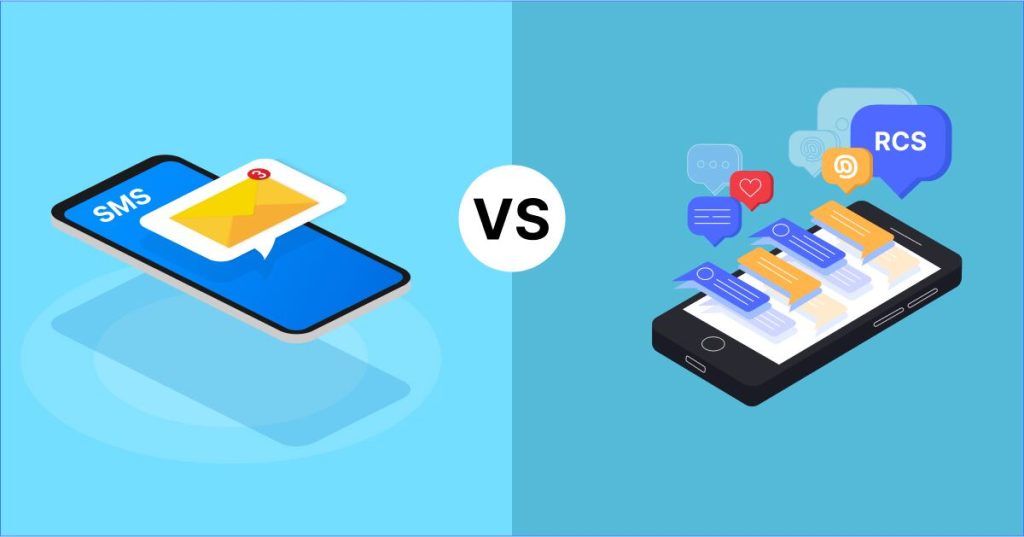
Let’s be honest: messaging is still one of the fastest, most reliable communication channels businesses leverage to connect with customers. However, when it comes to choosing the right messaging technology, it often comes down to RCS vs SMS. While SMS has been around for decades, RCS has stepped in as the next-gen upgrade. We’re talking about the evolution of messaging from plain, basic text to an interactive and engaging experience with multimedia and actionable elements
So, which one should your business be using?
Through this blog, we are going to explore both options with real-world examples, pros and cons, and how you can use them to make better customer connections.
What is SMS and How Does It Work?
Let’s have a quick refresher. Short Message Service (SMS) is a text-based communication protocol that enables the exchange of short text messages, up to 160 characters, between mobile devices. Introduced in the early 1990s, SMS messages are transmitted through the cellular network, similar to voice calls, and do not require an internet connection. This makes SMS universally accessible and reliable, even in areas without Wi-Fi or mobile data.
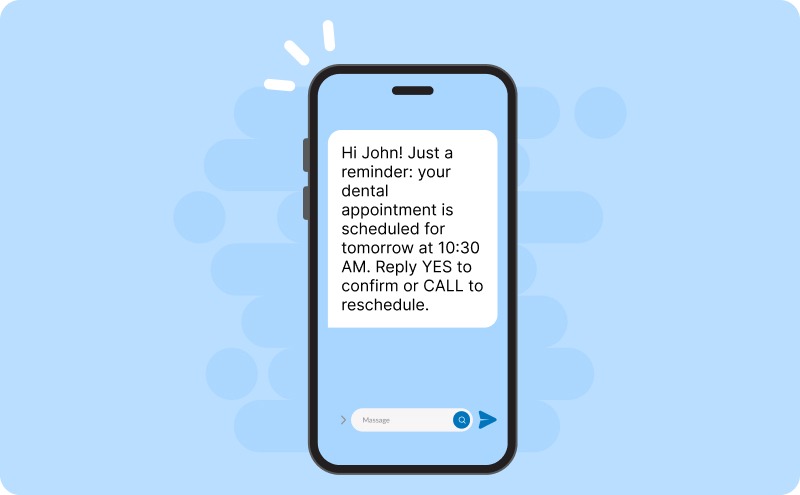
To put it more specifically, key features of SMS are:
- A limit of 160 characters per message
- Text-only; no support for images, videos, or interactive elements
- Utilizes the cellular network, messages can be sent without an internet connection
- Compatible with all mobile devices, regardless of brand or operating system
According to Earthweb Research, around 23-27 billion text messages are sent per day all over the world. Furthermore, Data indicates that 60% of consumers read their received text messages within the first 5 minutes. With these numbers, it’s tough to picture anything else taking over from SMS, isn’t it?
The primary advantage of SMS is its simplicity and widespread compatibility, allowing nearly any mobile user to send and receive messages. Businesses frequently use SMS for customer service and marketing due to its reliability and broad reach. However, SMS has limitations, including its 160-character limit and the inability to send multimedia content like images, videos, or audio.
MMS, the Multimedia Messaging Service (MMS), took text messaging a step further by allowing users to send and receive messages that include multimedia content. MMS uses the same cellular network as its predecessor, i.e., SMS, but supports larger file sizes, enabling the transmission of images, videos, and audio files.
Despite the rise of internet-based messaging apps like WhatsApp and Facebook Messenger, which offer advanced features and require an internet connection, SMS remains a crucial communication tool. Its ability to function without an internet connection and its universal compatibility ensure its continued global use.
SMS Use Cases

Now let’s add some more real-world flavor to this post by looking at the common use cases of SMS:
- Appointment Reminders
Hi Betty! Just a reminder: You’ve got a dental appointment tomorrow at 3:30 PM. Reply ‘1’ to confirm or ‘2’ to reschedule.
- One-Time Passwords (OTPs) for Authentication
Your OTP is 492301. Do not share this with anyone.
- Order Confirmations and Shipping Updates
Thanks for your order! Your package will be delivered on April 30th. Track here: [link]
What is RCS and How Does it Work?

It’s the next generation of messaging. Rich Communication Services (RCS) is a modern messaging protocol designed to enhance the traditional SMS experience with advanced features, similar to those found in popular messaging apps like WhatsApp and iMessage.
RCS allows users to send high-resolution photos, videos, and audio clips, engage in group chats, receive read receipts, see typing indicators, and has no character limit, all within their phone’s native messaging app without needing additional third-party apps. It supports real-time interactions, such as branded messages and location sharing, and offers end-to-end encryption for secure communications.
RCS works for both regular chats between people (P2P) and messages sent from businesses to customers (A2P). You’ll often hear it called RCS chat or RCS texting.
RCS is an open standard, meaning it can be integrated into any device without interoperability issues. However, both the sender and receiver must have RCS-compatible devices and be connected to either Wi-Fi or an LTE/5G network. While widely supported on Android devices, Apple devices currently do not support RCS, defaulting to SMS for communication with non-RCS users.
If we look at statistics about the adoption and growth of RCS, we find that
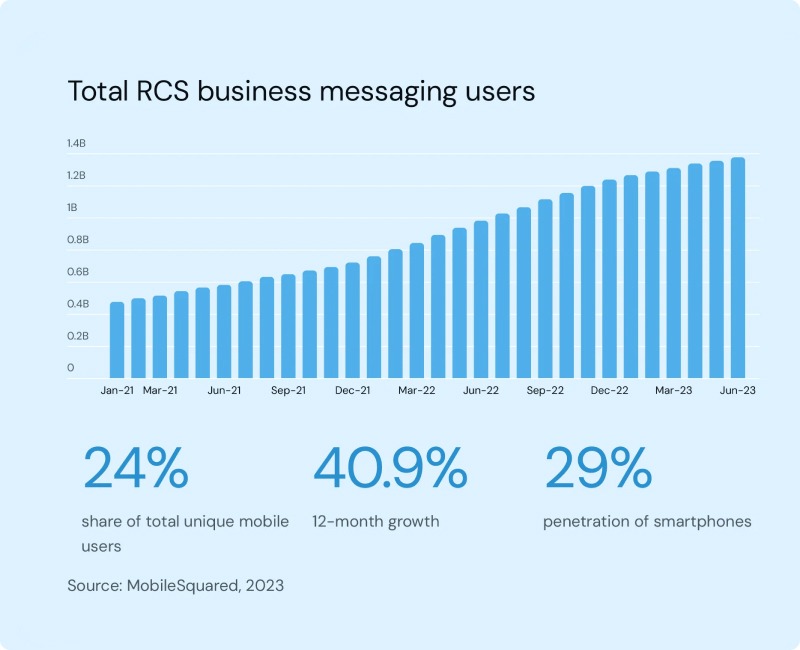
- RCS has over 1.1 billion active users globally as of 2024.
- RCS business messaging adoption surged by over 40% in June 2023 compared to the previous year.
For businesses, RCS provides a richer platform for customer interaction, enhancing communication with multimedia content and interactive elements, leading to higher engagement and conversion rates.
RCS Business Messaging (RBM) includes features like barcode delivery, click-through options, and carousel messages, facilitating seamless customer experiences directly within the messaging app. Here’s a stat that might surprise you: RCS messages are read 35 times more often than emails, making them a powerhouse for customer engagement.
Simply put, the main features of RCS are:
- Unlike SMS, which caps you at 160 characters, RCS lets you send messages without worrying about character limits.
- Supports rich media, i.e., images, videos, GIFs, and audio messages.
- Includes interactive elements such as buttons, carousels, and suggested replies.
- Provides read receipts and typing indicators so that users can see when messages are read and when the other party is typing.
- Offers branding opportunities as businesses can customize messages with logos and brand colors.
- Requires an internet connection (mobile data or Wi-Fi) for message delivery.
RCS Case Study: How Casas Bahia Achieved A 6.2x higher ROI with RCS?
Casas Bahia, one of Brazil’s largest retail chains, successfully leveraged Rich Communication Services (RCS) to enhance customer engagement and drive sales, particularly for their digital installment payment solution, “Carnê Digital.”
Impressive Results from RCS Implementation
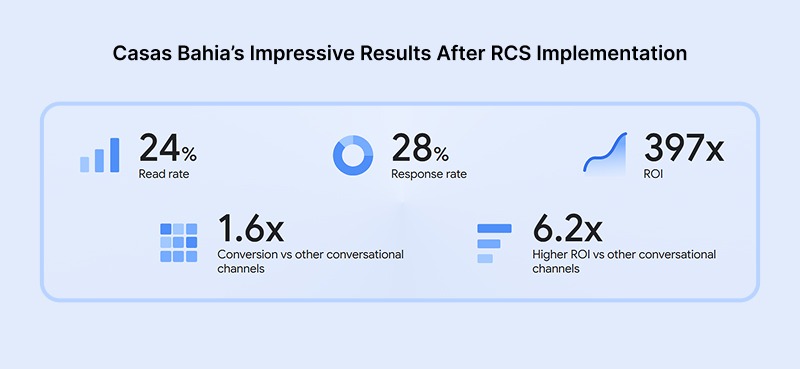
- 8% Increase in Orders
- 17% Boost in Sales Revenue
- 1.6x Higher Conversion
- 397x Return on Investment (ROI):
- 6.2x Higher ROI Compared to Other Channels
- 24% Read Rate and 28% Response
- Rate 1.6x Higher Conversion
The above figures demonstrate the potential of rich messaging platforms to revolutionize customer engagement and drive business growth in the retail sector.
Let’s move ahead and look at some more business areas where RCS can provide value.
RCS Real-world Use Cases
The use of RCS is similar to SMS in that it allows businesses to send messages directly to a user’s phone number. However, RCS takes things a step further by enabling rich, interactive experiences like carousels, images, videos, and suggested reply buttons, all within the default messaging app.
- With RCS, a business can send appointment reminder messages with a branded logo along with a map link to the location.
- RCS can step up OTP messages by including verified sender IDs and brand logos to make the message more trustworthy.
- With RCS, order confirmations can be like a message with an order image, a live tracking button, a support chat option, etc.
What is the Difference Between RCS and SMS?
RCS vs SMS can be discussed fundamentally in terms of their transmission methods and capabilities. SMS relies on the cellular network for transmission, functioning independently of internet connectivity, while RCS requires a data connection for message delivery. SMS is limited to 160 plain text characters, whereas RCS messages don’t have a limit and support rich media like high-resolution images, videos, and interactive elements. Additionally, RCS offers advanced features such as read receipts, typing indicators, and group chats, making it a more dynamic communication platform than SMS.
While SMS enjoys near-universal adoption across all mobile devices, RCS requires newer devices and compatible carriers. Users must also manually activate RCS on their phones, leading to inconsistent availability. RCS vs SMS’s distinct characteristics and features serve unique purposes, with SMS remaining a dependable method for immediate, broad-reaching communications, while RCS offers a richer, more interactive experience tailored for modern messaging needs.
Here is a table to help you easily understand SMS vs RCS Messages:
| Feature | SMS |
RCS |
| Usability | No app to download, found in native messaging app on all mobile devices | Need to activate from the default messaging app on Android devices |
| Reach | 100% of mobile phone users (approx. 7.3 billion) | Around one billion active Android users |
| Network Requirements | Requires cellular network | Requires internet connection (cellular data or Wi-Fi) |
| Character Limit | 160 characters per message | No specific character limit |
| Capabilities | Text only, no media attachments (except MMS) | Supports images, videos, GIFs, audio, and rich cards |
| Interactivity | Limited to text chat | Offers interactive elements like buttons, quick-reply, and suggested actions |
| User Experience | Basic text messaging | Enhanced with rich media, interactive features, and app-like experiences |
| Engagement | High open rate (>90%) | High engagement with 90% of messages opened within 15 minutes |
| Branding Opportunities | Limited to alpha sender IDs in some countries | Includes brand logos and verified sender information |
| Security | No encryption, vulnerable to interception | Can offer end-to-end encryption |
| Delivery Receipts | Delivery receipts available | Both delivery and read receipts available |
| Group Messaging | Basic group messaging capabilities | Advanced features like adding/removing participants and naming group chats |
RCS vs SMS Example
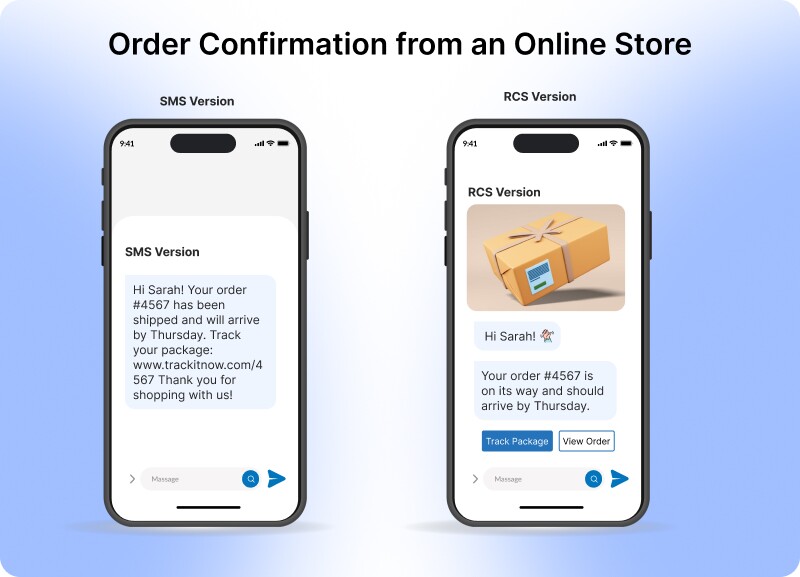
RCS vs SMS – Which is Better?
SMS has been around for decades. It’s a communication tool that just works, no matter what. However, with evolving consumer expectations, businesses have no choice but to upgrade, i.e., choose RCS.
Determining whether RCS or SMS is better depends on the context and user needs. For basic, reliable communication without the need for internet connectivity, SMS remains unmatched. Its simplicity and widespread adoption ensure that messages can be sent and received by virtually anyone with a mobile phone.
On the other hand, RCS is the clear winner for a more enhanced messaging experience that includes multimedia and interactivity. It offers a range of modern features that meet the demands of contemporary communication.
The choice between RCS and SMS doesn’t have to be complicated. Let’s give you some simple pointers to help you decide when to stick with SMS and when to level up with RCS:
When to Use SMS?
- Reaching Everyone is Your Priority
We all know that SMS works on every mobile phone, whether it’s a smartphone or not. If your customer base or audience consists of people using basic phones or older devices that do not support RCS, and you’re aiming for maximum reach, then SMS is your best bet.
- You’re sending basic, time-sensitive notifications
Simple yet urgent alerts like OTPs, appointment reminders, delivery updates, and emergency notifications essentially do not require rich texts. This means SMS can just get the message across quickly.
- You’re looking for an affordable option for short messages
SMS is cost-friendly and widely supported by all telecom providers. It’s a great choice for mass notifications where design isn’t important.
- You’re operating in regions where RCS isn’t yet supported
In many countries, RCS is still rolling out. Choosing SMS for message delivery will ensure your communication always gets delivered.
When to Use RCS?
- You want to deliver a premium, branded experience
RCS lets you add logos, colors, images, videos, and even carousels, which makes it perfect for brand engagement.
- You need customer interaction within the message
With RCS, you can add clickable buttons like “Call Now,” “Buy,” or “Track Order” to drive engagement and increase conversions.
- You want real-time feedback
Read receipts, typing indicators, and delivery confirmations let you know what’s happening. It’s like WhatsApp, but in native SMS apps.
- You want to reduce app dependence
RCS gives you app-like features without needing users to download anything. This is quite handy for one-time interactions or campaigns.
All in all, the need for RCS vs SMS boils down to the requirements of the user. For those seeking rich media sharing and interactive features, RCS offers a superior experience. However, for straightforward, reliable messaging without the need for the internet, SMS continues to be a robust choice. As mobile technology advances, the integration of both services could provide a seamless transition, allowing users to enjoy the best of both worlds.
Benefits of Using RCS Over SMS
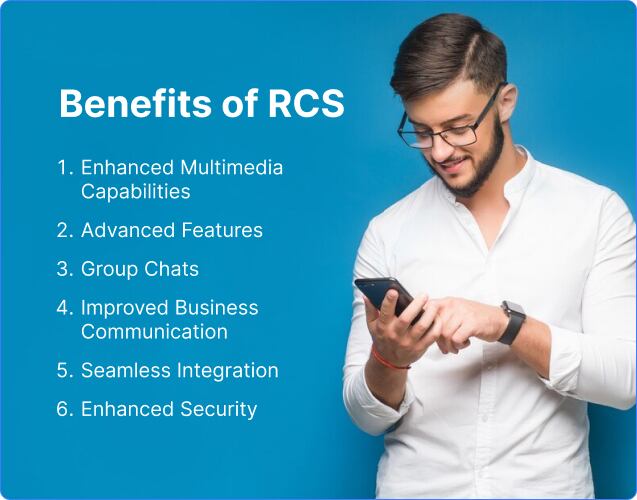
As mobile communication technology evolves, RCS is increasingly being seen as the successor to the traditional Short Message Service (SMS). The RCS vs SMS debate continues, but RCS offers a set of advanced features that significantly enhance the user experience. Here are some key benefits of using RCS over SMS:
1. Enhanced Multimedia Capabilities
One of the most significant advantages of RCS is its ability to handle rich media. Unlike SMS, which is limited to text messages of 160 characters, RCS supports high-resolution images, videos, audio messages, and even large files. This capability allows users to share more dynamic and engaging content, making communication more vivid and expressive. For businesses, this means they can send promotional materials, product images, and video demonstrations directly through messages, enhancing their marketing efforts.
And guess what? Studies show that 90% of rich media messages are opened within 15 minutes, with customers engaging for an average of 45 seconds, highlighting the impact of RCS content.
2. Advanced Messaging Features
RCS brings several advanced messaging features that SMS lacks. These include read receipts, typing indicators, and delivery notifications. With read receipts, users can see if their message has been read, which is particularly useful for time-sensitive communication. Typing indicators let users know when someone is composing a response, adding a layer of interactivity and engagement. Delivery notifications confirm that messages have been delivered successfully, ensuring effective communication.
3. Group Chats and Rich Interaction
RCS supports group chats, enabling users to communicate with multiple contacts simultaneously. This feature is ideal for both personal and professional use, allowing for efficient coordination and discussion within groups. Additionally, RCS includes rich interaction features such as suggested replies and actions, which streamline conversations and enhance user engagement. For instance, users can quickly reply to messages with predefined responses or take immediate actions like booking tickets or making reservations directly from the chat.
4. Improved Business Communication
Consumers don’t take trust lightly. According to a study by Edelman, 81% of people say they need to trust a brand before they even think about buying from it.
For businesses, RCS offers several advantages over SMS. RCS Business Messaging allows companies to interact with customers in a more interactive and personalized manner. Businesses can use RCS to send branded messages, integrate chatbots, and provide interactive customer service. These capabilities can lead to higher engagement rates and improved customer satisfaction. Moreover, the ability to send rich media content and interactive messages makes RCS a powerful tool for marketing campaigns and customer outreach.
5. Enhanced Security
RCS provides better security features than SMS. With the growing concern over data privacy and security, RCS offers end-to-end encryption for messages, ensuring that communications are secure and protected from unauthorized access. This level of security is crucial for both personal and business communications, providing peace of mind to users who are increasingly aware of privacy issues.
6. Seamless Integration with Other Services
RCS integrates seamlessly with other communication services and platforms. It can work alongside existing messaging apps and services, providing a unified and enhanced messaging experience. This integration allows users to enjoy the benefits of RCS without needing to switch to a completely new platform, making the transition smooth and convenient.
Benefits of SMS
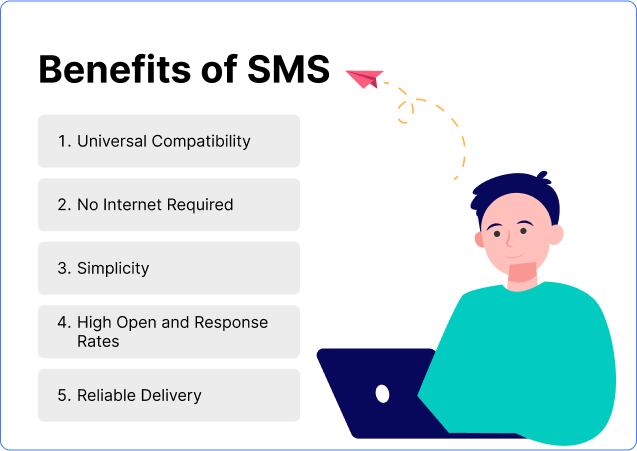
Despite the rise of advanced messaging platforms, SMS remains a staple in the world of communication. Introduced in the early 1990s, SMS is one of the most reliable and universally accessible messaging services. I’m going to highlight some key benefits of using SMS:
1. Universal Compatibility
SMS is universally compatible. It works on virtually all mobile phones, regardless of the make, model, or operating system. This widespread compatibility ensures that messages can be sent and received by nearly anyone with a mobile phone, making SMS an incredibly versatile communication tool.
2. No Internet Required
SMS does not require an internet connection to function, making it an ideal choice for areas with poor or no internet connectivity. This reliability ensures that messages can be sent and received in remote locations, during network outages, or in situations where data services are unavailable. For critical communication, such as emergency alerts or important updates, SMS provides a dependable solution that does not rely on internet infrastructure.
3. Simplicity and Ease of Use
The simplicity and ease of use of SMS are significant benefits. Sending a text message via SMS is straightforward and does not require any special skills or knowledge. This simplicity makes SMS accessible to users of all ages and technical abilities. Additionally, there is no need to download or install any additional applications, making SMS a convenient and hassle-free option for quick communication.
4. High Open and Response Rates
It boasts exceptionally high open and response rates compared to RCS. Studies have shown that SMS messages are typically opened within minutes of being received, and the response rates are significantly higher. This immediacy makes SMS an effective tool for urgent notifications, time-sensitive promotions, and real-time customer interactions.
5. Reliable Delivery
SMS offers reliable delivery of messages. Because SMS uses cellular networks rather than internet-based services, it is less susceptible to issues like server downtime or internet outages. This reliability ensures that messages are delivered promptly and accurately, which is crucial for both personal communication and business operations.
Can RCS Replace SMS?
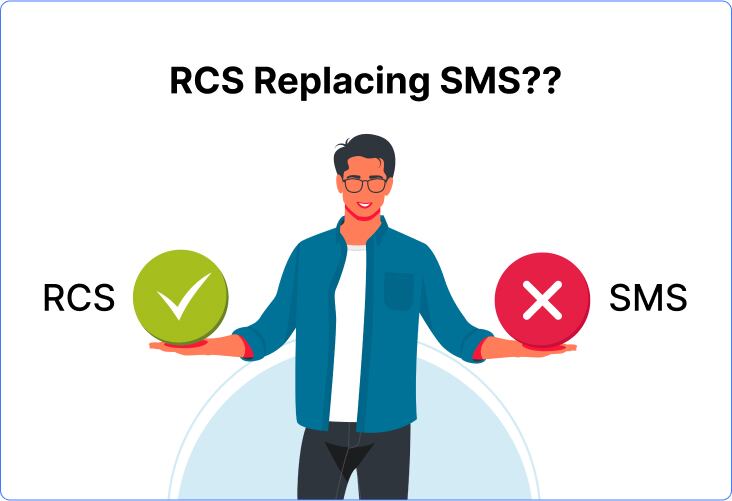
According to a study by Juniper Research, the number of RCS users is expected to increase from 1.2 billion in 2022 to 3.8 billion in 2026, and the revenue may reach more than 4.6 billion dollars.
In another research by tech analyst company Omdia, it has been found that RCS traffic, particularly Application-to-Person (A2P), is projected to experience significant growth, quadrupling from 1.5 trillion messages in 2024 to over 6 trillion by 2029. This growth will lead to a substantial revenue increase for A2P RCS, reaching $4.2 billion by 2029.
RCS supports high-resolution images, videos, audio messages, and large file transfers, and includes features like read receipts, typing indicators, and group chats. These capabilities make RCS a richer, more interactive communication tool compared to traditional SMS, positioning it as a strong candidate for replacing SMS.
For businesses, RCS offers significant advantages. RCS Business Messaging allows companies to send branded, interactive messages that include multimedia content and interactive buttons. This can enhance customer engagement and streamline customer service with chatbots. The enhanced security features of RCS, such as end-to-end encryption, also provide higher privacy and security for communications.
However, the transition from SMS to RCS faces challenges. RCS requires a stable internet connection, unlike SMS, which operates over cellular networks and does not depend on data connectivity. This makes SMS more reliable in areas with poor or no internet access. Additionally, both the sender and the receiver must have RCS-enabled devices and be on networks that support the protocol, whereas SMS works universally across all mobile devices.
So, while RCS offers many advantages over SMS, its reliance on internet connectivity and the need for widespread compatibility present significant hurdles. As infrastructure and adoption improve, RCS may gradually become the standard for mobile communication, but until then, SMS will continue to play a crucial role. The transition to RCS will likely be a gradual process, with both services coexisting for the foreseeable future.
How to Use RCS and What Devices Support It?
Rich Communication Services or RCS is an upgrade to traditional SMS. It works similarly to popular messaging apps such as WhatsApp and iMessage, providing a richer and more interactive communication experience.
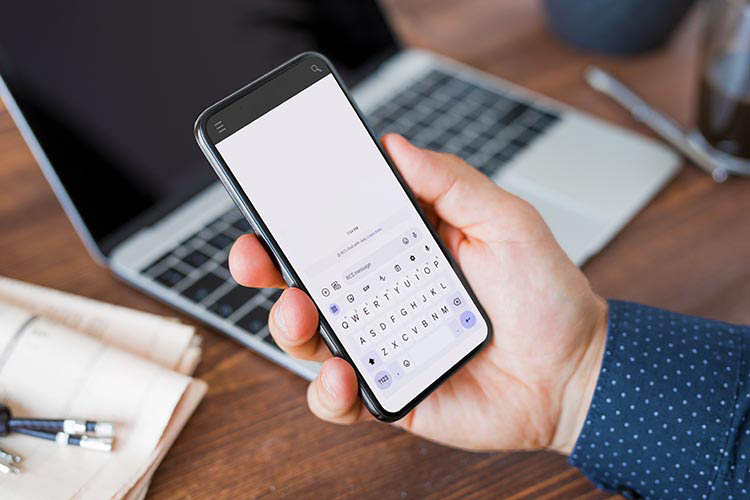
Previously, RCS was only supported on Android devices running OS 5.0 and higher. However, Apple has also rolled out RCS support with iOS 18 in September 2024. With this release, the number of people who can receive rich, interactive messages has shot up. Major carriers around the world support the Universal Profile for RCS. This ensures compatibility across various networks and devices.
How to use RCS on Android?
To use RCS on your Android device, follow these steps:
- Check Device Compatibility: Ensure your Android device supports RCS. Most recent models from all manufacturers support it.
- Update Google Messages App: Go to the Google Play Store, search for “Google Messages,” and update the app if necessary.
- Set Google Messages as Default: Open the Google Messages app and set it as your default messaging app if prompted. You can do that from settings as well.
- Enable Chat Features: In the Google Messages app, tap your profile picture or icon in the top-right corner, select “Messages Settings”, then “General”, and after that “RCS Chats”. Toggle on “RCS Chats” and you’re done.
- Start Messaging: Open a conversation in the Google Messages app, compose your message, and look for “Chat message” or similar indications that RCS is active.
How to Use RCS on iOS?
To use RCS on your iOS device, follow these steps:
1. Ensure your iPhone is running the latest version of iOS, which is iOS 18.
2. Verify that your mobile carrier supports RCS messaging on iPhones.
3. Enable RCS:
- Open the Settings app.
- Tap on “Apps”. Tap on “Messages”.
- Tap on “RCS Messaging”.
- Toggle the switch to the “On” position.
4. It might take a few hours for RCS to activate on your device.
By following these steps, you can enjoy the enhanced messaging experience offered by RCS. Please note that these steps may be different depending on your carrier, Android or iOS version, or device manufacturer.
Tips to Engage Customers with RCS Business Messaging
Business Messaging is transforming with the help of RCS chatting. By offering a richer, more interactive experience than traditional SMS, RCS can enhance customer interactions and boost engagement. Here are some effective tips to make the most of RCS Business Messaging:

- Use customer data to tailor messages to individual preferences and behaviors. Address customers by their names and send customized offers based on past purchases.
- Include images, videos, and GIFs to make messages visually appealing. You can also use rich media to demonstrate products, share tutorials, or highlight features.
- Utilize interactive buttons for actions like scheduling appointments, making purchases, or accessing customer support.
- Incorporate quick reply options to facilitate easy customer responses.
- Send timely notifications about order status, delivery updates, and appointment reminders. Ensure customers are informed and up-to-date, reducing uncertainty and enhancing satisfaction.
- Use AI-powered chatbots to handle common queries and provide instant responses.
- Assure customers with verified sender identification to build trust. Utilize end-to-end encryption to protect sensitive information.
- Run interactive marketing campaigns that involve polls, surveys, and quizzes.
- Provide a direct channel for customer service through RCS, making it easy for customers to reach support.
- Monitor the performance of RCS campaigns using analytics tools. Continuously refine messaging strategies based on customer response data.
Conclusion
The debate of RCS vs SMS highlights the significant evolution in mobile messaging technology. While SMS remains a reliable and widely used communication tool, its capabilities are limited compared to the advanced features offered by RCS. RCS not only enhances the user experience with rich media, interactive elements, and real-time communication but also provides businesses with a more robust platform for engaging customers. So, the choice between RCS and SMS ultimately depends on the desired communication outcomes and the need for richer, more interactive customer interactions.
Frequently Asked Questions
Still got Questions? This quick FAQ should sort you out!
What are the business advantages of using RCS over SMS?
SMS is just plain text, while RCS combines it with images, videos, and other interactive elements. This helps businesses with better branding, improved customer interaction, and thus drives more engagement.
Is RCS better for promotional or transactional messages?
RCS is actually useful for both promotional and transactional messages. Promotional messages like flash sale updates with images, videos, and countdown timers, along with CTA buttons, can generate more customer engagement compared to plain text. In case of transactional messages, like appointment reminders and order delivery updates, businesses to add a branded touch through tracking links, rich receipts, and even support chats.
Can RCS messages fall back to SMS if RCS isn’t available?
Yes, the mechanism through which RCS messages fall back to SMS in case of non-availability of RCS is called “fallback”. Suppose the recipient device or the carrier doesn’t support RCS, your message will still be delivered, but only the plain, core part, and not the images, buttons, or any other rich elements. So, if you have a customer base with RCS-supporting and non-RCS devices, then RCS appears to be a reliable communication channel for you.
Do RCS and SMS work with the same mobile number?
Yes, you don’t need any new number or new app to send SMS and RCS messages, and even the recipients receive these messages within their same native messaging app on their phone.
How is RCS different from SMS in terms of user experience?
SMS is just plain text in any language; there are no images, no interactive elements. On the other hand, RCS involves high-resolution images, videos, typing indicators, and read receipts, which gives users an experience like chatting on any instant messaging app, such as Facebook.
Does SMS support read receipts and typing indicators?
No. Once an SMS is sent, there is no clue whether the message is being read and a reply is being typed. However, with RCS, this is possible as this technology enables you to see if someone has read your message or if they are typing a reply. This adds a real-time feel to the interaction.
Do RCS messages cost more than SMS?
Yes, but there are good reasons for their high cost. The pricing of RCS is determined by various factors, including the provider and the features.






















